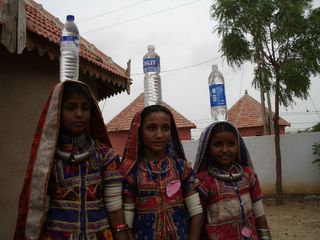It struck me long ago that age, like time, is relative. Many people I have met in India do not know how old they are; many women become mothers at a time when I would perceive them to still be in their childhood. I understand that seeing ‘age’ as a milestone for life is oftentimes a very western way of viewing the world.
But seeing girls as young as 7 precariously balancing pots of water a few times their weight atop their heads, swathed under layers of ornate clothing and bedecked with heavy jewelry, all in the soaring desert heat, left me speechless. In the lines that crisscrossed their small faces, in the precocious worry that shone through their eyes, I could sense that their concerns were far graver than anything I had ever thought about as young child. Though I am aware that far too many children across the globe have to shoulder ‘adult’ responsibilities at a young age due to financial necessity, it grabbed at my throat to see these little girls looking and acting like miniature versions of themselves 20 years into the future.
I was in Kutch last weekend for an exhibition of the Rural Design School in the village of Ludiya. The region of Kutch (which comes from kachbo, which means tortoise), due to its proximity to the Indo-Pak border and its unique geographical terrain, has maintained a distinct cultural flavor. The embroidery and woodcarvings of the region have received acclaim throughout the world for their intricacy and striking designs. The embroidery of the region, in particular, is of high artistic merit; generations of girls begin to embroider from a young age in order to prepare a large dowry collection for their weddings. (clothing similar to what they are wearing in the photos)
With its customs and traditions having been largely untouched over the last hundreds of years owing to its geographical isolation, Kutch has in recent years seen a sharp inflow of tourists looking to see an idealized ‘picture of India’. The tourism industry has had a negative effect on, amongst other things, the artwork of the region. Where once women embroidered using their creativity and skill, many now have begun producing inferior quality pieces purely for commercial purposes. This had the effect not only of undermining the work of women who had the talent and inclination to create high-quality pieces, but it also began to deprive women of an important – and perhaps the only -- outlet for themselves.
The Rural Design School was started in 2002 as a joint project between Indicorps and an NGO called Manav Sadhna “with the goals of helping the women build confidence, find their voice and use their own lives as the inspiration to create their own style of embroidery.” Though the project has waged countless uphill battles over the course of its existence mainly due to resistance from village men, in recent times, many village men and women have begun defying custom to support it as they see that it is in their best interest. (A woman was slapped by her father-in-law for wanting to leave the home for the day to showcase her goods at the exhibition; after he left her house, she braved the journey and made it to the exhibition).
While walking with two young girls (in picture) to the water pump one morning, I tried to muddle my way through the thickets of GujaratiKutchi to understand what their chatter was about. It seemed centered around food, family, siblings, and water. They were probably going to go back home, help with the cooking, care for their siblings, do some embroidery, and wait for the next day to come.
These girls probably don’t go to school, and probably never will. Like many women across the world, their opinions, thoughts and ideas will probably forever stay confined within their heads, manifested only in the care with which they do the cooking, the care for their homes, extended families, and children. Embroidery, however, might give these girls a chance to explore their creativity, share their skills, and gain some financial independence.
When I think of how many women across the world are silenced either overtly or covertly by factors beyond their control, I’m grateful for initiatives like the Rural Design School. For it's initiatives such as these which remind me that even when stifled by the heaviest of hands, our voices can still shine through.

